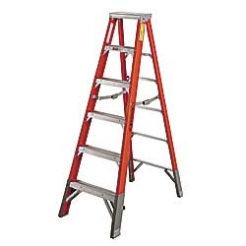
Stepladders are commonly found in practically any work environment. They provide a handy, efficient way to reach elevated work areas quickly and conveniently. But they also are potentially dangerous and can result in injury and even death if used incorrectly.
Training workers to follow good safety practices while using stepladders is the easiest way to reduce or eliminate dangers from fall, electrocutions and other potential ladder-related hazards.
Standard Stepladder Features
The standard stepladder is portable and self-supporting. It has an A-shaped frame and usually has two front side rails and two rear side rails. Most stepladders have steps that are mounted between the front side rails. How many steps a stepladder has depends on its height. On the rear side rails, most ladders have bracing that provide support and stability.
The first thing any worker should do before using a stepladder is to inspect it for damage or instability. If there are any broken rungs or rails, bent or split side rails, missing or damaged safety devices, or other structural damage, the ladder should not be used. Check the steps for grease, dirt or other substances that could cause a slip or fall.
Be aware of paint or stickers — except manufacturer safety warnings or labels — that could hide possible defects.
Stepladder Load Ratings
The next thing to consider is the stepladder’s load capacity. Not all stepladders are made alike. There is actually a stepladder rating system that standardizes the load capacity of any particular stepladder:
Type III – Light duty designed for household use. Maximum load capacity is 200 pounds.
Type II – Medium duty designed for commercial use. Maximum load capacity is 225 pounds.
Type 1 – Heavy duty designed for industrial use. Maximum load capacity is 250 pounds.
Type 1A – Extra heavy duty designed for industrial use. Maximum load capacity is 300 pounds.
Type 1AA – Special duty designed for rugged use. Maximum load capacity is 375 pounds.
If the body weight of the person using the stepladder — combined with any materials or equipment that are being used while on the ladder — exceed the maximum load capacity, it could cause the ladder to fail, which may result in a fall and/or injury.
Be Aware of the Work Environment
Before using a stepladder, workers should always inspect the area in which the ladder will be used. Don’t use the ladder if there are any overhead power lines or exposed electrical cables even if the ladder is not made out of metal.
When climbing a ladder, make sure to use three-point contact — two hands and a foot, two feet and hand — when moving up or down the stepladder. Keep your body in the center of the ladder and always face the ladder’s rungs while climbing up or down.
If necessary, use a barricade to keep pedestrians and traffic away from the area where you will be using the ladder. Make sure the ladder is on a stable and level surface before climbing it.
The spreaders of the stepladder should always be in the locked position before use. Never use a stepladder for a purpose other than that for which it was designed, such as using a folded stepladder as a single ladder.
A piece of equipment as innocuous as a stepladder can pose a potential danger when it is not used safely or wisely. Make sure all employees are adequately trained on the proper use of stepladders and other equipment in order to minimized injuries and danger in your workplace.
